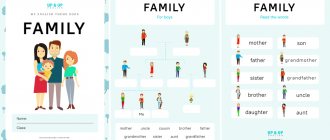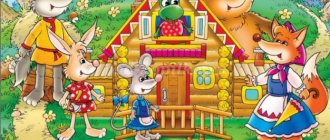Notes of OOD in English (20 notes) lesson plan (senior group)
Lesson outline on the topic: “Colors”. (senior group) (Stereotyping-situational stage - formation of automation).
Goal: development of lexical and grammatical skills using a fairy tale on the theme “Colors”.
Tasks:
1. Teach children new lexical units on the topic “Colors”: purple, golden, beige, turquoise.
2. Continue to teach children to act according to the model.
3. Continue teaching children to use speech patterns: “It is…”, “I like…” “What is it?”.
Language material for active use in speech:
-names of colors (green, yellow, red, blue, pink, brown, orange, grey, white, black, purple, golden, beige, turquoise).
Language material for recognition:
-commands (Let's see it, Let's repeat, Please, take your chairs and go out!)
Expected results:
1. Children will be able to act according to the model.
2. Children will learn to use speech patterns “It is…”, “I like…” “What is it?” using LE on the topic: “Colors”.
3. The children mastered the proposed language material.
1. Organizational moment. (3 min)
T: “Hello, my dear children! I am glad to see you! How are you?”
CH: “I am fine”
T: “Very well! I am fine too!”
T: “Guys, let’s start our lesson by repeating our greeting poem! Turn to each other and say good morning!” (Poem)
SN: Good morning, good morning,
Good morning to you,
Good morning, good morning,
I'm glad to see you.
T: “Good for you! Well done!”
2. Main part. (21 min)
T: “Children, they are many colors in English. Let's see it! (On the board there are cards of the colors that the children already know (Green, red, blue, yellow, brown, white, black, orange, grey, pink)). Please name these colors. For example, it is green. What is it?” (Children take turns calling the colors, then ask each other). (2 min)
T: “That`s right! And now I will tell you a fairy tale about the octopus Gosha. I'm sure you'll like it! Only some of the words in it are written in English, so when you hear them, say them out loud in Russian! All right? Agreed?
SN: “Yes”
T: “In the huge deep ocean lives the octopus Gosha. He likes everything colorful, beautiful, bright. That's why he loves to look at small fish that move in moving schools here and there... They are very bright, colorful and cheerful!
And for many days the octopus dreams that someday he will learn to draw, and that he will always be surrounded by colorful paintings. And so, Gosha began to look for paints, because there is so much on the bottom of the ocean! But he always came across something wrong - shipwrecks, chests, even skeletons...
Finally, he found jars of paints among other things, lined them up in front of him and began to examine them. “Oh, what wonderful, magnificent colors!” - Gosha said.
“Here is green, it’s like algae; This is yellow, it’s like sand.”
Seeing a jar of red paint, Gosha thought about it. What does red look like? Oh yes! “red is like coral, and blue is like the sky!” Even an octopus living in the depths of the ocean knows what color the sky is, because it also sometimes looks up...
At that moment, a school of fish swam by. They were so beautiful and colorful! And pink, and brown, and orange, and grey! And everyone was scurrying up and down!
And Gosha, too, admiring them, looked up and down! And so, when he looked up again, the octopus saw the white sail of a yacht through the water. It was beautiful too. He liked white as well as other colors.
Gosha, returning to his jars and remembering what colors he had seen during the day, began to test his memory. Looking at his “treasures,” he said: “green looks like grass and algae; - yellow looks like sand and the sun; -red, same as corals; - blue, the same as the sky! And these colors - pink, brown, orange, gray - are like the scales of cheerful little fish that swam up and down.
And Gosha had two more colors in jars. One of them is white, like the sail of the yacht he saw that day. And the other color is black. Gaucher didn't really like this color.
He reminded him of the not best days of his childhood, when his mother scolded little Gosha because his neck was dirty and black. “And how did I manage to get my neck dirty, being in the water all the time?” - the matured Gosha sometimes thought.
Now he understood his mother. I also understood that a dirty and black neck is ugly. But, the octopus thought, if you paint everything black, and then draw patterns or fish on top in different, bright colors, it will be beautiful...
Gosha is very tired. He went to bed and fell asleep happy. Because tomorrow he will DRAW!” (8 min)
T: “Guys, did you like the fairy tale?”
SN: “Yes!”
T: “That's great! Wonderful! But you and I don’t know the names of all flowers, would you like to know a few more? Then look at our magical flower! Look at the magic flower! What colors are its petals?
CH: “purple, golden, beige, turquoise.”
T: “That`s right! Purple will be purple in English. Repeat, please! For example, a purple ball. Golden will be golden. Repeat, please all together! For example, a golden ball. Beige will be beige, a beige ball. And turquoise is turquoise, a turquoise ball. Let's repeat!" (together and individually). (5 min)
T: “Good for you, my dears!” Well, have you stayed too long? Stand up, my children!” (Physical education minute)
When I see red I put my hands on my head.When I see blue I touch my shoe. When I see green I wash my face real clean. When I see yellow I wave to the fellows. When orange is found I put my hands on the ground. When I see pink I think, I think, I think. (2 times)
T: “Very well! Sit down, please!” (2 min)
T: “Now let’s mix our paints (pictures with colors are mixed and turned face down) and play “Yes or no,” okay?” (Children take turns taking out one card with a color, look at the color, but do not show it to anyone, and others must guess this color using the questions “Is it...?”. The one who guesses takes the place of the leader).
T: “Kira, is it red?”
SN: “No, it isn`t” (Further according to the sample).
T: “That's perfectly correct. Absolutely right." (4 min)
3. Final part. (2 min)
T: “Guys, what new colors did we learn today? What did you like most about today's lesson?
SN: “I found out that purple is purple in English”
T: “Well done! Our lesson is over! Thanks for good job! Please, take your chairs and go out!”
How to learn English in kindergarten
Today, knowledge of English, which has become the universal language of communication throughout the world, is no longer an advantage, but rather a necessity. It is not surprising that parents want their young children to know this language perfectly. In what cases should you take a closer look at kindergartens where all communication is exclusively in English? What are the main advantages of private kindergartens, where a lot of time is devoted to language learning? Let's look into these issues together with Evgenia Andreicheva, an English teacher.
Evgenia Andreicheva, English language teacher, graduate student of the Department of Foreign Philology, Moscow State Pedagogical University
English from kindergarten: where and how
Your child can become acquainted with English in the most ordinary state kindergarten. Most often, classes are held there 1-2 times a week for 45 minutes and can be a good basis for further acquaintance with the subject when the child gets older
English is studied more intensively in private kindergartens. Usually they have not only Russian-speaking staff - teachers and assistants, but also English-speaking staff - English teachers, among whom there may be both our compatriots and expats. They work with children for several hours every day: they organize activities, play, and read in English. At the same time, children communicate with each other and with teachers in Russian. Some of these kindergartens call themselves English, but in reality this is just a marketing ploy.
A real English kindergarten is an educational institution where all the staff, from teachers and teachers to assistants, speak English. Absolutely all activities there - exercises, walks, reading books, games and even lunches and breakfasts - take place in English, and children are taught by native speakers. Staying in such a kindergarten is maximum immersion in the language environment. But it is very expensive, and few families can afford to send their child to such a kindergarten.
Parents' goals and choice of kindergarten
If your goal is simply to introduce your child to the English language and prepare him for more in-depth study at school, additional, paid classes in a public kindergarten may be suitable for you. But here it is worth considering several factors. It is important that classes are conducted in small groups in a playful way (with the study of songs, poems, acting out skits) and involve a constant return to previously studied material. This means that at each lesson the child not only learns something new, but also consolidates knowledge from previous lessons. When children are simply learning letters and sounds and becoming familiar with words, without making sentences; when this happens in the format of a school lesson, without games; when there are 10 or more people in a group, such activities will not bear fruit.
Do you want your child to have a basic understanding of grammar, acquire vocabulary, learn how to construct sentences, and be able to carry on a conversation before entering school? A private kindergarten that teaches English may be a good option.
If you intend to raise a graduate of a prestigious university or college in the UK and the US who will speak and think equally well in both languages, then a more thorough approach (for example, training in a real English kindergarten) and your participation is needed.
How to raise a bilingual
In order for a child to be equally proficient in both his native and foreign languages, it is necessary to create conditions for him to be equally immersed in language areas. This means that the child should devote the same amount of time to the two languages. Bilingualism cannot develop if the family and child speak Russian, in kindergarten English is only two to three hours a day, and then the child communicates with peers, one of the teachers, the coach, and junior staff in Russian.
It’s a completely different matter if in a private kindergarten he regularly attends foreign language lessons, and at home and on walks you talk a lot and read books to him in English. Then good conditions are created for the development of bilingualism.
But the best way to develop bilingualism is to stay in a real English kindergarten. It’s good when the groups in it are mixed and multinational: it is important that the child’s brain does not relax from using their native speech. Classes in English kindergartens are often divided into mini-groups, and children are often deliberately moved from one to another in order to eliminate the effect of getting used to the environment and enhance the perception of information. This has a beneficial effect on learning English.
But even in this case, do not forget to pay attention to English outside of kindergarten.
When will the benefits of language lessons be maximum?
By sending their child to an English kindergarten or a private kindergarten to study a language, parents expect that in the future the child will master it quickly and easily. This is partly true: children's brains develop very quickly, so children learn new information much better than adults.
But in the future, this knowledge will be useful only if the child learns English constantly, without taking long breaks. The language will be forgotten very quickly if you don’t use it. As I already said, teaching English in the garden should be supported by using the language in the natural environment. This means that the child needs communication with an adult who speaks the language and with other English-speaking children. Ideally, he will meet them on trips abroad or have an English-speaking friend to communicate on Skype.
In addition, it is very important to take into account the personality of the teacher, both in a regular private kindergarten and in real English. If a person is a native speaker, this does not mean that he knows how to teach. It is important that he understands how to work with preschoolers, knows teaching methods, and has the necessary equipment and materials. Sometimes teachers deliberately focus not on speaking, but on listening or reading. In this case, other types of speech activity become secondary, and the skill of using them fades away. Unfortunately, poor teaching methods can prevent your child from speaking another language. This problem can be encountered in any kindergarten.
Do you need to learn several languages at once?
In some kindergartens, children not only learn English, but also get acquainted with other European languages, and sometimes even Chinese. And although it is easier to learn something new at an early age, do not strive at all costs to raise a polyglot. Serious study of several foreign languages at once is a burden on the child’s brain, which should be approached wisely. Often, children learning two or more languages get confused in vocabulary, experience problems with the phonetic format of speech, and transfer words and phrases from a foreign language to their native one. This does not mean that your child cannot learn both English and French at once with equal success - this is an individual question. But you should be prepared for the problems listed above and realize that a trilingual kindergarten is not always better than a kindergarten with one language.
Choosing a preschool institution is a very important step. In kindergarten, your child will not only study English, so pay special attention to the training of teachers, the variety of activities, including sports, conditions for maintaining health, and nutrition. And don’t forget to create every opportunity for your child to learn English outside of kindergarten.
Glen Doman Method
In Russia, the method of teaching English to preschoolers, authored by Glen Doman, is popular. It is used both in kindergartens and various children's clubs, and by parents at home. Already from 6-7 months, babies are shown cards with pictures of words, while pronouncing a foreign word out loud.
The child remembers the picture and learns new words with regular, but not prolonged, repeated viewing of the cards. Subsequently, effectively conduct games with different combinations of cards and show presentations. The child’s role in learning using the Glen Doman method is passive, but in this visual form it is not difficult for him to remember new vocabulary.
How to individualize work with children in the process of educational activities in English
Issues of individualization of work with children are relevant for learning English, since its development depends on the characteristics of the memorization process, the ability to concentrate on a particular type of activity, as well as on the type of temperament: choleric people, as a rule, comprehend new material more easily than phlegmatic people. An individual approach to developing correct pronunciation, which is determined by the child’s speech development, deserves special attention. Some people can easily repeat the sound complexes of a foreign word, while others cannot reproduce even half of the sounds in the correct order. Work with such children should be based on the technique of choral repetition: first, the teacher pronounces the word himself, and then together with the child. In this case, with each repetition, the volume of the adult’s voice should decrease and gradually fade away. In addition, the methods of individualization are:
The task of individualization is to find a task to suit each child’s taste, that is, to create conditions for a situation of success.
Zaitsev's technique
The next common technique is that of Nikolai Zaitsev. Suitable for both toddlers and older preschoolers. To teach younger children, the teacher (or parents) give them specially designed blocks with syllables to form words with. Those. memorization occurs in a playful and visual form. The next level also uses cubes.
The main idea is to make the algorithm for constructing sentences in English clear and simple. For each member of a sentence there is a specific color, and the child, having memorized the order of colors, say, for negative sentences, trains to form words under dictation. This is not an easy task for children, but its effectiveness has been proven.
The methodology also includes various manuals and tables, thanks to which parents themselves can conduct lessons without any problems.
English for preschoolers
Contained in sections:
Includes sections:
Consulting parents when organizing online English classes In a pandemic, distance learning is necessary as part of lifelong education. Based on this, a program was created to continue learning English on the basis of a bilingual group. for the implementation of distance learning in English .
Using the immersion method in English classes at preschool educational institutions The requirements of our society for the level of mastery of a foreign language are growing every day. Modern language classes are not just about repeating new words and phrases after the teacher and clarifying the meaning using the native language , it is an integrated approach aimed at developing language skills .
Publication “Use of new technologies in English classes in. “Our life does not stand still and modern classes and lessons in a foreign language are not just repeating new words and phrases after the teacher and clarifying the meaning using their native language, it is an integrated approach aimed at developing language competence in children. With help.
Health-saving technologies used in English classes at preschool educational institutions Preserving the health of preschool children is a priority area of education. The key positions of modern English classes from the point of view of health protection include not only taking into account the individual characteristics of preschool children, a differentiated approach to children with.
Consultation “English for Children” Parents strive to introduce their children to learning English already in infancy. What could this be - a tribute to fashion or a desire to use the opportunity to experiment and get real results? Controversy over learning English in kindergarten.
Summary of an open lesson on teaching Russian-speaking children Tatar and English “Multi-colored dishes” Summary of an open lesson on teaching Russian-speaking children Tatar and English “Multi-colored dishes”. Developed and conducted by teacher Leontyeva E.A. Topic: “Multi-colored dishes” Program objectives: Expand children’s vocabulary in the Tatar language, develop the ability to understand.
Article “Tips for parents on teaching children English at home (in the summer.” Summer holidays come, when you don’t have to rush to kindergarten in the morning, when there is a lot of free time that can (and should) be spent usefully. In a relaxed atmosphere it is very useful turn on simple cartoons and audio recordings for your baby while he plays, makes noise, and runs around.
Outline of an English language lesson in a preparatory group Outline of joint educational activities with children 6-7 years old in English Educator of the MADOU "KINDERGARTEN No. 11" in Zarechny, Penza region Inna Konstantinovna Makovskaya Goal: to develop children's interest in learning English language through songs and rhymes.
Source







